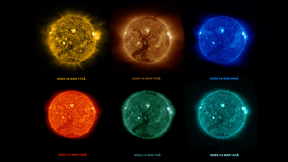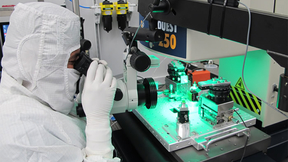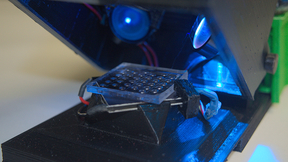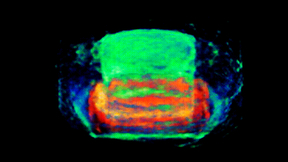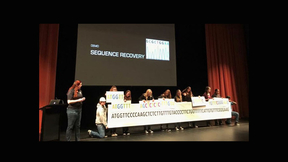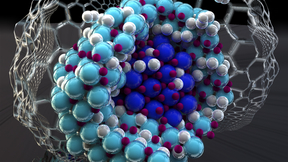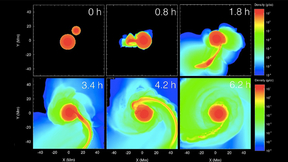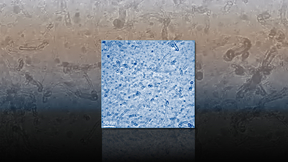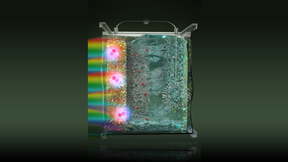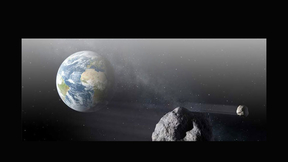Back
Physical and Life Sciences
Here comes the sun in first-time images
The first images from the Solar Ultraviolet Imager (SUVI) instrument aboard the National Oceanic and Atmospheric Administration’s GOES-16 satellite capture a large coronal hole on the sun. The Geostationary Operational Environmental Satellites (GOES) are part of NOAA’s space weather monitoring fleet. GOES-16 launched late last year. GOES-16 (known as "GOES-R" before its…
The softer side of NIF hohlraums
Considering that nothing precious comes from an online retailer without protective padding, could precision laser targets also benefit from similar high-tech swaddling? So far the answer is yes, for a group of scientists developing new target technologies for NIF that are intended to neutralize what they believe is one of the bigger challenges to achieving ignition. The…
A new toolkit for rapid bacterial detection
Finding the right treatment plan for patients who have antibiotic-resistant infections is a costly and time-consuming effort. For doctors in rural areas or developing countries, there often is no source of electricity nearby or sterile lab conditions with microbiology specialists on hand. The current standard for bacterial identification is to isolate and grow the species…
Weisz selected for Hutcheon Fellowship
A Lawrence Livermore National Laboratory (LLNL) postdoc who was mentored by Lab scientist Ian Hutcheon has been named the first recipient of the Department of Homeland Security’s (DHS) new fellowship that honors Hutcheon. David Weisz, who has worked at the Lab since August as a chemist in the Chemical and Isotopic Signatures Group, has been selected to receive the "Dr. Ian…
Forensic Science Center Earns 7th Consecutive OPCW 'A' Grade
Despite a worldwide ban, chemical weapons pose a legitimate threat to global security. In 2013, rockets deployed the nerve agent sarin over a populated area of Syria, killing hundreds of people and hospitalizing thousands more. In accordance with the Chemical Weapons Convention (CWC) Treaty, the Organisation for the Prohibition of Chemical Weapons (OPCW) leads…
It's a blast: Imaging high explosive detonators
Lawrence Livermore National Laboratory (LLNL) scientists and collaborators at Los Alamos National Laboratory (LANL) for the first time have taken 3D snapshots of operating high explosive detonators. Scientists from LLNL, Los Alamos and National Security Technologies, LLC (NSTech) combined state-of-the-art imaging capabilities with computed tomographic reconstruction (X-ray…
‘Science on Saturday’ lecture combines biomedical and computational power to decode rabies
On February 11, hundreds filled the Bankhead Theater in downtown Livermore for a presentation titled “Reconstructing a Rabies Epidemic: Byte by Byte.” As part of Lawrence Livermore National Laboratory’s (LLNL’s) educational outreach program Science on Saturday, the interactive lecture featured biomedical scientist Monica Borucki, bioinformatics scientist Jonathan Allen,…
Scientific team develops nano-sized hydrogen storage system to increase efficiency
Lawrence Livermore scientists have collaborated with an interdisciplinary team of researchers, including colleagues from Sandia National Laboratories, to develop an efficient hydrogen storage system that could be a boon for hydrogen-powered vehicles.Hydrogen is an excellent energy carrier, but the development of lightweight solid-state materials for compact, low-pressure…
From the Lab to the marketplace: Lab-Corps provides a boost to cryogenic compression
Hydrogen offers a wide variety of benefits to today's challenges for carbonless transportation (such as zero tail-pipe emissions, rapid refueling and longer driving range), but its widespread commercialization is still limited due to high costs. Cryogenic compression would help make carbonless transportation a practical reality. That’s where Guillaume Petitpas of Lawrence…
Lab-Corps experience inspires application of carbon capture technology to untapped industry
Sometimes a scientific breakthrough can end up in the most unexpected places. Just ask Congwang Ye, a Lawrence Livermore National Laboratory (LLNL) engineer whose work with carbon capture microcapsule technology, intended for filtering CO2 from power plants, could end up solving a big problem for craft beer makers.In December, Ye participated in the Department of Energy’s…
Kepler, don't give up on the hunt for exomoons
The Kepler spacecraft has been prolific in its search for planets outside our solar system, known as exoplanets, discovering thousands since its launch in 2009. But the hunt for moons orbiting these exoplanets, or exomoons, is vastly more challenging. While no exomoons have been found to date, a new study shows that the search is not futile. Researchers have demonstrated…
Next-gen dark matter detector in race to finish
U.S.-based experiment is on a fast track to help solve science mystery._________The race is on to build the most sensitive U.S.-based experiment designed to directly detect dark matter particles. Department of Energy (DOE) officials today formally approved a key construction milestone that will propel the project toward its April 2020 goal for completion.Lawrence Livermore…
Nanotube growth moving in the right direction
For the first time, Lawrence Livermore National Laboratory scientists and collaborators have captured a movie of how large populations of carbon nanotubes grow and align themselves.Understanding how carbon nanotubes (CNT) nucleate, grow and self-organize to form macroscale materials is critical for application-oriented design of next-generation supercapacitors, electronic…
Meet Ivy Krystal Jones
Editor's Note: This is one in a series of articles highlighting the diverse group of Lawrence Livermore National Laboratory postdocs and graduate scholars.The postdoc program at Lawrence Livermore National Laboratory provides opportunities for postdocs to conduct world-class research in an exciting, diverse and often interdisciplinary environment. Postdocs are involved in…
Plate tectonics go to the core
The heat from Earth’s core has a significant effect on tectonic plate movement.The new research challenges the previous school of thought that movement of Earth’s tectonic plates is driven largely by negative buoyancy created as they cool.The team, including Lawrence Livermore National Laboratory scientist Nathan Simmons and university collaborators, combined observations…
Meet Tom Braun
Editor's Note: This is one in a series of articles highlighting the diverse group of Lawrence Livermore National Laboratory (LLNL) postdocs and graduate scholars.___________________ Full Name: Tom BraunHometown: Berlin, GermanyEducation: Braun received his master’s degree in physics from Technical University Munich, Germany and his Ph.D. in materials science from Technical…
Lab pulsed-ion beam experiments reveal radiation damage processes in silicon
Materials scientists at Lawrence Livermore National Laboratory (LLNL) have used a novel pulsed-ion-beam method to identify mechanisms of radiation defect formation in silicon.The research could have implications for improvements in modern electronics performance.Understanding radiation defects in crystals has been a major materials physics challenge for decades. Stable…
Carbon-free energy from solar water splitting
A Lawrence Livermore National Laboratory (LLNL) scientist and collaborators are fine tuning the mechanisms to generate hydrogen from water and sunlight. Hydrogen production offers a promising approach for producing scalable and sustainable carbon-free energy. The key to a successful solar-to-fuel technology is the design of efficient, long-lasting and low-cost…
Meet Madison Martin
Editor's Note: This is one in a series of articles highlighting the diverse group of Lawrence Livermore National Laboratory postdocs and graduate scholars._________Full name: Madison MartinHometown: Cooper City, FloridaEducational background: Martin received a bachelor’s degree in math and physics from Florida Atlantic University Honors College, her master’s degree in…
Janus Laser Furthers Planetary Defense Research
Defending Earth against incoming asteroids—uncommon but potentially catastrophic threats—is no easy task. Without convenient, cost-effective ways to experiment directly on asteroids in the solar system, scientists run simulations and conduct high-energy-density experiments on asteroid fragments with lasers. Those who need to study matter under extreme conditions find a…


